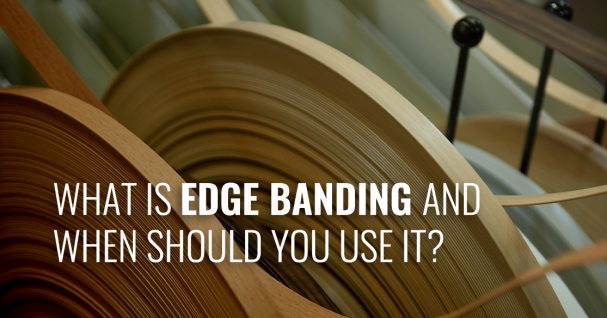
Rough or unfinished edges are not the most sought after look when building furniture or cabinet. But, when using plywood or particle board, it is common to have edges where the grain and finish do not match the other sides. Sometimes, those raw edges aren’t a problem — they’re destined to be hidden as a cabinet shelf or a woodworking project where function trumps finish. However, when aesthetics are important, there is an easy solution: edge banding.
What Is Edge Banding?
Edge banding is sometimes a thin strip of veneer, with adhesive on one side, that covers raw and exposed sides of particleboard and plywood. In other cases, edge banding is solid wood (usually from scraps) that is applied with glue or by making a groove in the piece of wood it needs to fit. These bands can be made to match the color of the piece of wood to which they will be applied. When applied with care, plywood edge banding makes the entire plank look like a solid piece of wood.
However, there is one (barely) noticeable feature of edge banding, but unless your houseguests are inspecting your furniture with a magnifying glass, they likely won’t notice it. Wood had three types of grain: edge, end, and face. Each of these grains run in a different direction, which is how to tell the different types apart. When using edge banding, though, you see edge grain where you would normally see end grain. Now, to the untrained — and even the trained — eye, the difference in the grain is not so stark that it becomes the focal point of a piece. Not to mention, edge banding, regardless of the direction its grain is, is a far more pleasing sight than the raw or exposed edges it is covering.
When To Use Edge Banding
Edge banding is used for two reasons: durability and aesthetics. Raw, unfinished edges of plywood and particle board are easier to damage. Edge banding, using either the veneer or solid wood options, reinforces the sides of the piece it is attached to, helping it survive wear and tear better than unfinished wood and protecting it from the elements. Now, you might not think the inside of a cabinet gets as much wear as, say, a tabletop, but when you’re regularly moving pieces in and out of a cabinet or changing shelf heights, it can affect the quality of the piece more than you think. Edge banding can withstand regular bumps, scrapes, and knocks much better than raw edges.
But, more than durability, the most common reason woodworkers and DIYers employ edge banding is for the look. Regardless of whether you’re seeing the exposed edge on the piece of plywood you’re working with, having every side of it match in terms of color and texture is important. It takes away the “homemade” look of a project, adding polish and refinement to an otherwise inexpensive piece of wood.
Plywood Edge Banding Is Easy
For at-home projects, it’s less likely you’ll use (or even have!) solid wood scraps that can be cut and fit into plywood. Not to mention, veneer edge banding is far simpler to apply and trim to the perfect fit. Often, it only requires equipment most homes already have — a sharp knife and a hairdryer or iron — and it does not take long to apply.
Because projects can change as you go, as do the uses of the wood you’ve bought and finished, edge banding is an easy option to make sure each side of a piece of wood matches and doesn’t need to be refit if you repurpose the project (changing from enclosed cabinets to open shelving, for example). It will also make sure the project to which you gave your time and money withstands all manner of wear.
Enhance durability and aesthetics effortlessly with our expert edge banding solutions. Contact us to refine your woodworking projects to perfection!



